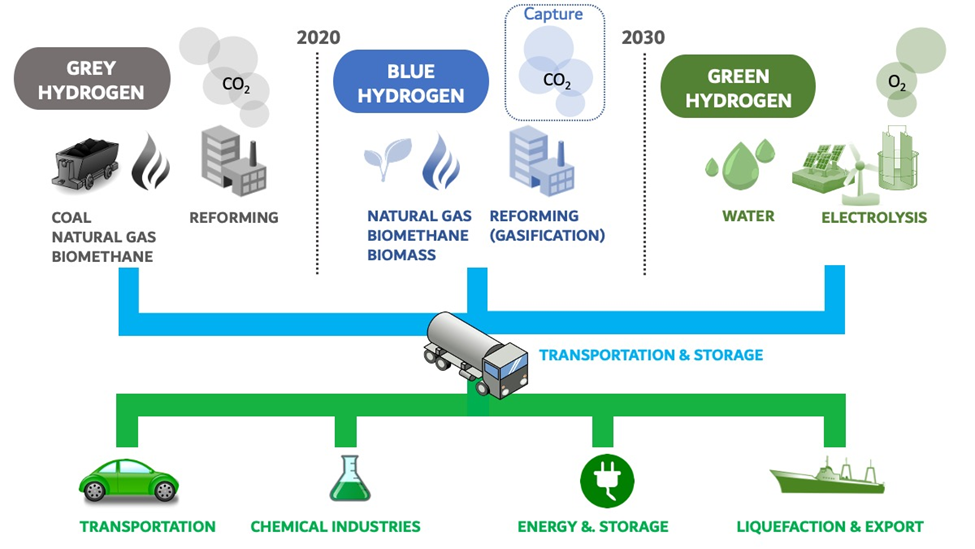Electric vs Hydrogen – There is a Clear Choice for the Marine Sector
We often get asked to compare electric propulsion to hydrogen fuel cells. Each has their advantages. In the long-run, we believe one will be the clear winner and this blog post explains why.
Vessel operators are in a difficult dilemma of having to invest in a lot of zero-emission energy generation/storage that does not effectively meet the energy needs in most use cases, but is essential for having zero-emission operation today. The challenge is that no zero-emission energy generation or storage comes has the energy density of diesel (see table below) as measured by the specific energy in watt hours per kilogram.
|
Energy Storage/Generation |
Specific Energy (wh/kg) |
Cost per kWh of storage |
Cost per kWh of operation* |
|
Diesel Fuel |
12,700 |
N/A |
N/A |
|
Lead Acid Battery |
~60 |
$175 |
16.6 ¢ |
|
Lithium Battery – LiPO4 |
~150 |
$800 |
16.6 ¢ |
|
Lithium Battery – NMC |
~250 |
$1,000 |
16.6 ¢ |
|
Sodium (solid state) Battery G1 |
~60 |
$20,000 |
15.2 ¢ |
|
Sodium (solid state) Battery G3 |
~250 |
Unknown |
15.2 ¢ |
|
Hydrogen Fuel Cell |
~277 |
$10,000 |
50 ¢ |
*15¢per kWh of electricity used for electricity rate; 90% efficiency for lithium battery, 99% for solid state, 30% for hydrogen
It is for this reason that the majority of research has focused on accelerating the energy density of zero-emission energy storage/generation. If one only looks at this factor, hydrogen stands out because it has the energy density of renewable energy storage options. Hydrogen advocates focus on the energy density rationale in extolling the role hydrogen could play for zero-emissions transportation.
Looking long-term, Green Yachts believes the energy density of batteries will increase and Moore’s Law will drive down the cost of producing new energy storage/generation technology. Because of this, long-term operating costs, not energy density, will drive market adoption of renewable energy storage solutions. It is for this reason that we see the majority of industry investments being made in increasing the specific energy of lithium batteries and developing solid state batteries with solid state batteries having the additional benefit of being safe and lasting up to 100,000 cycles compared to 1,500 cycles for a lithium battery.
Hydrogen will face long-term difficulty because the efficiency of converting electricity to green hydrogen and delivering it to a vessel for use has a 30% efficiency compared to 90% for lithium batteries and 99% for solid state batteries. For example, 200 kWh put into green hydrogen and used in a hydrogen generator will net 60 kWh of usable electricity on the vessel whereas 200 kWh put into a lithium battery bank and used on the vessel will provide 180 kWh of electricity.
Many hydrogen advocates claim higher efficiency, but this is for grey or blue hydrogen, which are both produced by separating natural gas into hydrogen and carbon dioxide – not exactly a renewable fuel source. The difference between the two is that for blue hydrogen ~65% of the carbon dioxide is recaptured (and 35% emitted into the atmosphere).

But with all the talk about hydrogen as a renewable fuel source, one would think that the majority of hydrogen is green hydrogen and used in zero-emission vehicles and other green efforts? Not exactly.

Hydrogen is mostly used in oil refineries and ammonia production. Only 4% of hydrogen is green hydrogen produce by electricity (and the actual green, green hydrogen produced by renewable energy is even smaller). Because producing green hydrogen is so inefficient, one has to pay 300% more for energy to use green hydrogen than straight electricity.
It is for this reason that in 2017, Yoshikazu Tanaka, chief engineer in charge of the Toyota Mirai – the largest commercial effort to develop and sell passenger vehicles powered by hydrogen in the world, told Reuters, “Elon Musk is right — it’s better to charge the electric car directly by plugging in {than to use hydrogen}.”
What does this mean? As our lead installer says, “30 years ago, hydrogen was the fuel of the future. Today, people are saying hydrogen is the fuel of the future. And you know what, 30 years from now, folks will still be saying that hydrogen is the fuel of the future.”
Because of the inherent inefficiency of producing green hydrogen and because the marine sector depends upon operational efficiency to be a competitive transportation sector, we do not see hydrogen every becoming a preferred energy storage solution in the marine sector outside of dedicated, long-distance, ocean crossing cargo and shipping vessels.
Is there a role for green hydrogen in zero-emission transportation? Hydrogen requires efficient and quick fueling of a fuel source kept below its boiling point of –423 ºF (–253 ºC) and its melting point of –434 ºF (–259 ºC). This requires complex and expensive infrastructure. The best deployment of this infrastructure is where many large EVs can be refueled at one location. Airports and large ports could have enough scale to make expensive and difficult liquid hydrogen refueling possible.
Hydrogen has the most potential in the aviation sector (https://www.businessairportinternational.com/features/a-growing-number-of-airports-are-taking-steps-to-prepare-for-hydrogen-powered-flights.html) because air transportation is less price elastic than marine transportation and the majority of airplane trips originate out of the busiest 500 airports around the world. Conversely, in the marine sector, instead of centralized infrastructure, there are tens of thousands of ports, docks and marinas. At these ports, docks and marinas, Level 1 and Level 2 electric vessel charging infrastructure already exists at every slip or dock. The disaggregated marine infrastructure combined with existing electric charging capacity and the 70% cost operating advantage of electric compared to hydrogen are strong factors indicating the marine industry is more likely to reduce emissions through electrification instead of adopting hydrogen.
At Green Yachts, we believe that all renewable energy storage systems have a long way to go. As we look at the development of renewable energy, we believe it is important to identify what long-term drives will dictate what energy storage solutions get adopted. In the aviation sector that is less price elastic and has centralized fueling that serve many planes at regional and international airports, hydrogen, the energy density of hydrogen could outweigh the economic and infrastructure hurdles. In the marine sector with disaggregated infrastructure and a high emphasis on operational efficiency, battery storage and electric charging appear to be a more viable long-term solution.
Consequently, we at Green Yachts believe that lithium batteries are the best renewable energy storage choice today for the marine sector and solid state batteries will be the best renewable energy storage 10-20 years from now. Going electric today with lithium batteries in systems designed right will have these batteries last long enough for their eventual replacement to occur when solid state battery technology has had time to develop and prices to come down 10-20 years from now. We see no similar pathway for exchangeable technology development for hydrogen in the marine sector.


Leave Comment